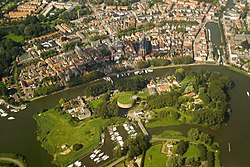Weesp
Weesp | |
|---|---|
 Aerial view of Weesp | |
 Location in North Holland | |
| Country | Netherlands |
| Province | North Holland |
| Government | |
| • Body | Municipal council |
| • Mayor | Bart Horseling (PvdA) |
| Area | |
| • Total | 24.16 km2 (9.33 sq mi) |
| • Land | 22.79 km2 (8.80 sq mi) |
| • Water | 1.37 km2 (0.53 sq mi) |
| Elevation | 1 m (3 ft) |
| Population (January 2021)[4] | |
| • Total | 20,445 |
| • Density | 897/km2 (2,320/sq mi) |
| Demonym | Weesper |
| Time zone | UTC+1 (CET) |
| • Summer (DST) | UTC+2 (CEST) |
| Postcode | 1380–1383 |
| Area code | 0294 |
| Website | www |
Weesp (Dutch pronunciation: [ʋeːsp] ) is a town and a municipality in the Netherlands, in the province of North Holland. It had a population of 20,445 in 2021.
Weesp lies next to the rivers de Vecht and Smal Weesp and also next to the Amsterdam-Rhine Canal. It is in an area called the "Vechtstreek". It is only 3 km from the end of the Amsterdam metro, but the wide Amsterdam-Rhine Canal keeps it geographically separate. The town is surrounded by open grassland.
Economy
The most famed product of Weesp is Van Houten chocolate. Before cocoa production, the local economy had been based on beer breweries, jenever distilleries, production of Weesper porselein, and trade, due to its location on a branch point of waterways. In the 21st century, the economy is very diverse. There were large facilities of Solvay Pharmaceuticals, until February 2010 when Abbott Laboratories of North Chicago, IL, USA acquired Solvay Pharmaceuticals. At this site there is a chemical plant which manufactures active pharmaceutical ingredient for Abbott brands Duphalac and Duphaston and a biologic plant which manufactures active pharmaceutical ingredient for Abbott's flu vaccine Influvac. The local specialty is the Weesper Mop cookie, which is based on mashed almond.
Tourism
Weesp is a popular stop for tourists. It has a protected historical center with canals and many buildings dating from the seveneenth and eighteenth century. Weesp has three full-size historical windmills. It features a bastion and fortifications that are part of the Defense line of Amsterdam and the Dutch Water Line. These structures have never been attacked, though. The scenic river Vecht and the small roads that line it attract yachters and cyclists. The Naardermeer area, the first nature reserve in the Netherlands, is at 15 minutes cycling distance from Weesp.
History
Until the early Middle Ages the region around Weesp was an uninhabited peat bog. Weesp (Wesopa in Latin documents) was granted city rights in 1355 and celebrated its 650th anniversary as a town in 2005.
From the late Middle Ages, the river Vecht was a defensive line for the County of Holland and it remained a military defensive line until the Second World War. Weesp was strongly fortified, more than its size would justify - for most of its history it had a few thousand inhabitants.
The defensive lines consisted of inundation zones, which would be flooded in wartime. Behind them were fortified towns, forts, barracks and other military structures. The most comprehensive was the Defence Line of Amsterdam (Stelling van Amsterdam), a circular inundation zone around Amsterdam, a UNESCO World Heritage Site.[5]
After the Second World War, new housing was built in the west and an industrial zone with a harbour at the Amsterdam-Rhine Canal was constructed. In the 1970s a suburb was built on the south. Another suburb was built in the north which recently expanded with plans for further expansion.
Before the reformation the church was dedicated to Saint Laurens. It is still in use for Protestant services. In the tower it has a famous carillon by Pieter Hemony cast in 1671. Following the 19th Century emancipation of Dutch Catholics, a Catholic church was erected in Weesp.
Population centers
The municipality of Weesp consists of the following cities, towns, villages and/or districts: De Horn, Uitermeer, Weesp. The north of Weesp itself has the Hogewey dementia village.
Local government
The municipal council of Weesp consists of 17 seats, which are divided as follows:
- WSP - 5 seats
- GL - 3 seats
- CDA - 2 seats*
- PvdA - 2 seats
- VVD - 3 seats*
- D66 - 2 seats*
- Article 50 - 1 seat
Transport
Weesp has one railway station, Weesp. It serves as a transfer station for passengers on local trains on the Amsterdam-Amersfoort and Schiphol Airport-Almere lines, which bundle up just before Weesp and diverge right after. Weesp therefore benefits from 16 departures per hour, serving many destinations including Amsterdam Central Station, Schiphol Airport, Amersfoort, and Utrecht 4 times per hour.
In front of the railway station is a small bus station with services to neighbouring towns and villages such as Muiden, Muiderberg, and Nigtevecht, and to Amsterdam Bijlmer ArenA railway station.
See also
References
- ^ "College B&W" (in Dutch). Gemeente Weesp. Retrieved 24 March 2014.
{{cite web}}: Unknown parameter|trans_title=ignored (|trans-title=suggested) (help) - ^ "Kerncijfers wijken en buurten 2020" [Key figures for neighbourhoods 2020]. StatLine (in Dutch). CBS. 24 July 2020. Retrieved 19 September 2020.
- ^ "Postcodetool for 1381BD". Actueel Hoogtebestand Nederland (in Dutch). Het Waterschapshuis. Retrieved 24 March 2014.
{{cite web}}: Cite has empty unknown parameter:|trans_title=(help) - ^ "Bevolkingsontwikkeling; regio per maand" [Population growth; regions per month]. CBS Statline (in Dutch). CBS. 1 January 2021. Retrieved 2 January 2022.
- ^ Defence line of Amsterdam on the UNESCO website
External links
 Media related to Weesp at Wikimedia Commons
Media related to Weesp at Wikimedia Commons Weesp travel guide from Wikivoyage
Weesp travel guide from Wikivoyage- Official website Template:Nl





